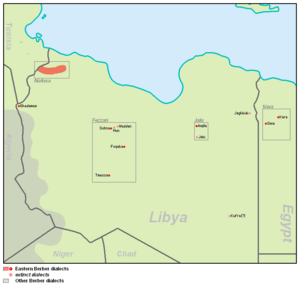| Eastern Berber | |
|---|---|
| Geographic distribution | Libya, Egypt |
| Linguistic classification | Afro-Asiatic
|
| Subdivisions | |
| Language codes | |
| Glottolog | None |
 | |
The Eastern Berber languages are a group of Berber languages spoken in Libya and Egypt. They include Awjila, Sokna and Fezzan (El-Fogaha), Siwi and Ghadamès,[1] though it is not clear that they form a valid genealogical group.
Eastern Berber is generally considered as part of the Zenatic Berber supergroup of Northern Berber.
Classification
[edit]Kossmann (1999:29, 33)[2] divides them into two groups:
- one consisting of Ghadamès and Awjila. These two languages are the only Berber languages to preserve proto-Berber *β as β;[3] elsewhere in Berber it becomes h or disappears.
- the other consisting of Nafusi (excluding Zuwara and southern Tunisia), Sokna (El-Foqaha) and Siwi. This shares some innovations with Zenati, and others (e.g. the change of *ă to ə[4] and the loss of *β[3]) with Northern Berber in general.
Blench (ms, 2006) lists the following as separate languages, with dialects in parentheses; like Ethnologue, he classifies Nafusi as Eastern Zenati.[5]
The "Lingvarium Project" (2005) cites two additional languages: the extinct language of Jaghbub and the still-spoken Berber language of Tmessa, an oasis located in the north of the Murzuq District.[6] Blažek (1999) considers the language spoken in Tmessa as a dialect of Fezzan.[7]
Notes
[edit]- ^ Aikhenvald, Alexandra Y. & A. Ju. Militarev. 1984. Klassifikacija livijsko-guančskih jazykov. In IV vsesojuznaja konferencija afrikanistov "Afrika v 80-e gody: itogi i perspektivy razvitija" (Moskva, 3-5 oktjabrja 1984 g.), vol. II, 83-85. (Tezisy Dokladov i Naučnyh Soobščenij IV). Moskva: Institut Afrika Akademii Nauk SSSR, as cited in Takács, Gábor. 1999. Development of Afro-Asiatic (Semito-Hamitic) Comparative-Historical Linguistics in Russia and the Former Soviet Union. (LINCOM Studies in Afroasiatic Linguistics 02). München: LINCOM Europa, p. 130
- ^ Maarten Kossmann, Essai sur la phonologie du proto-berbère, Rüdiger Köppe:Köln
- ^ a b Kossmann 1999:61.
- ^ Karl-G. Prasse. "The Reconstruction of Proto-Berber Short Vowels", in ed. James & Theodora Bynon, Hamito-Semitica, The Hague/Paris 1975.
- ^ AA list, Blench, ms, 2006
- ^ "Africa. Berber language" (PDF). lingvarium.org. Retrieved 18 April 2023.
- ^ Václav Blažek, "Numerals: Comparative-etymological Analyses of Numeral Systems and Their Implications : Saharan, Nubian, Egyptian, Berber, Kartvelian, Uralic, Altaic and Indo-European Languages", in: Filozofická Fakulta: Opera Universitatis Masarykianae vol. 332, p. 57, Facultas Philosophica - Masarykova Univerzita Brno, 1999 (ISBN 9788021020702)
External links
[edit]